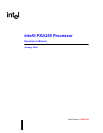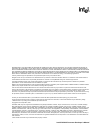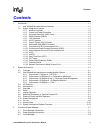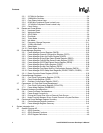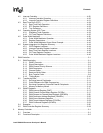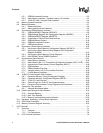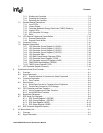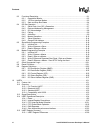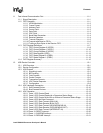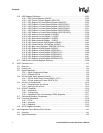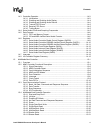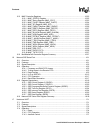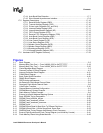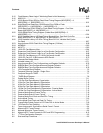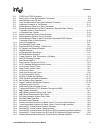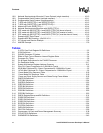
viii Intel® PXA255 Processor Developer’s Manual
Contents
9.3 Functional Description .......................................................................................................9-1
9.3.1 Operational Blocks................................................................................................9-3
9.3.2 I2C Bus Interface Modes .....................................................................................9-3
9.3.3 Start and Stop Bus States ....................................................................................9-4
9.4 I2C Bus Operation .............................................................................................................9-7
9.4.1 Serial Clock Line (SCL) Generation......................................................................9-7
9.4.2 Data and Addressing Management ......................................................................9-7
9.4.3 I2C Acknowledge..................................................................................................9-8
9.4.4 Polling...................................................................................................................9-9
9.4.5 Arbitration .............................................................................................................9-9
9.4.6 Master Operations ..............................................................................................9-12
9.4.7 Slave Operations ................................................................................................9-14
9.4.8 General Call Address..........................................................................................9-16
9.5 Slave Mode Programming Examples ..............................................................................9-18
9.5.1 Initialize Unit .......................................................................................................9-18
9.5.2 Write n Bytes as a Slave.....................................................................................9-18
9.5.3 Read n Bytes as a Slave ....................................................................................9-18
9.6 Master Programming Examples ......................................................................................9-19
9.6.1 Initialize Unit .......................................................................................................9-19
9.6.2 Write 1 Byte as a Master ....................................................................................9-19
9.6.3 Read 1 Byte as a Master ....................................................................................9-20
9.6.4 Write 2 Bytes and Repeated Start Read 1 Byte as a Master..............................9-20
9.6.5 Read 2 Bytes as a Master - Send STOP Using the Abort ..................................9-21
9.7 Glitch Suppression Logic.................................................................................................9-21
9.8 Reset Conditions .............................................................................................................9-21
9.9 Register Definitions..........................................................................................................9-22
9.9.1 I2C Bus Monitor Register (IBMR) .......................................................................9-22
9.9.2 I2C Data Buffer Register (IDBR).........................................................................9-22
9.9.3 I2C Control Register (ICR)..................................................................................9-23
9.9.4 I2C Status Register (ISR)...................................................................................9-25
9.9.5 I2C Slave Address Register (ISAR)....................................................................9-27
10 UARTs........................................................................................................................................10-1
10.1 Feature List......................................................................................................................10-1
10.2 Overview..........................................................................................................................10-2
10.2.1 Full Function UART ............................................................................................10-2
10.2.2 Bluetooth UART..................................................................................................10-2
10.2.3 Standard UART ..................................................................................................10-2
10.2.4 Compatibility with 16550.....................................................................................10-2
10.3 Signal Descriptions..........................................................................................................10-3
10.4 UART Operational Description ........................................................................................10-4
10.4.1 Reset ..................................................................................................................10-5
10.4.2 Internal Register Descriptions.............................................................................10-5
10.4.3 FIFO Interrupt Mode Operation ........................................................................10-21
10.4.4 FIFO Polled Mode Operation............................................................................10-22
10.4.5 DMA Requests..................................................................................................10-22
10.4.6 Slow Infrared Asynchronous Interface..............................................................10-23
10.5 UART Register Summary ..............................................................................................10-26
10.5.1 UART Register Differences ..............................................................................10-28



